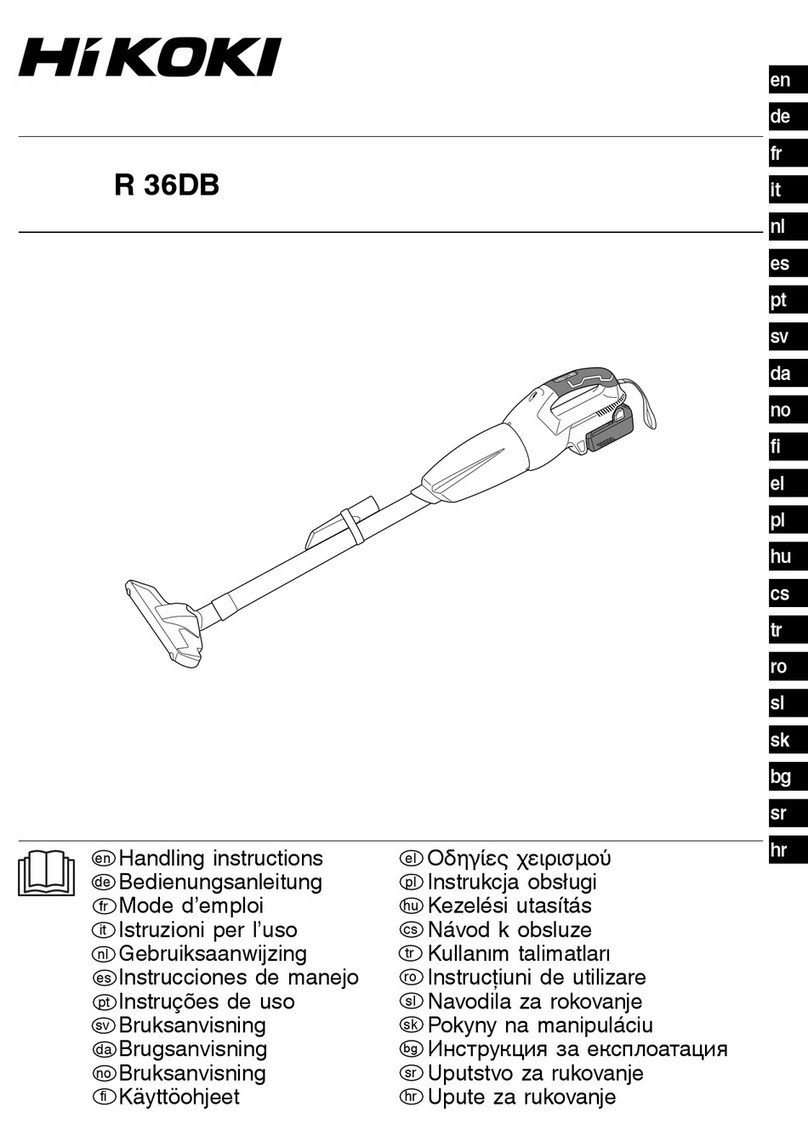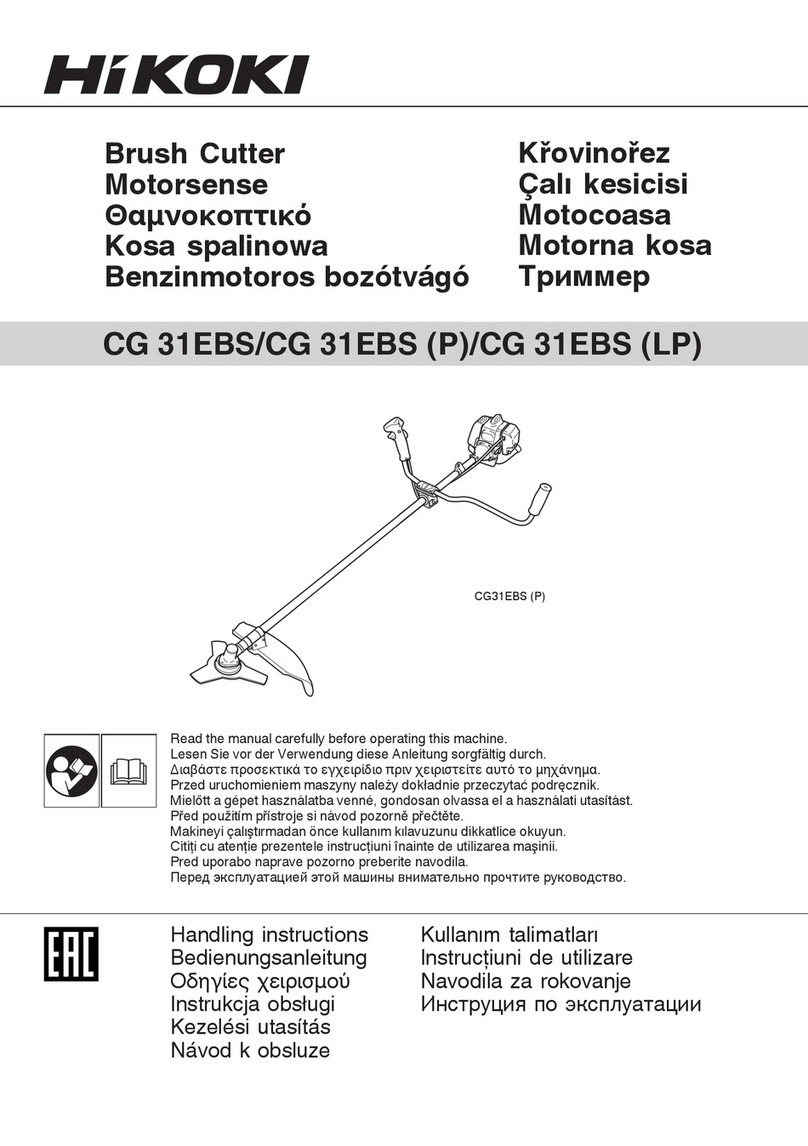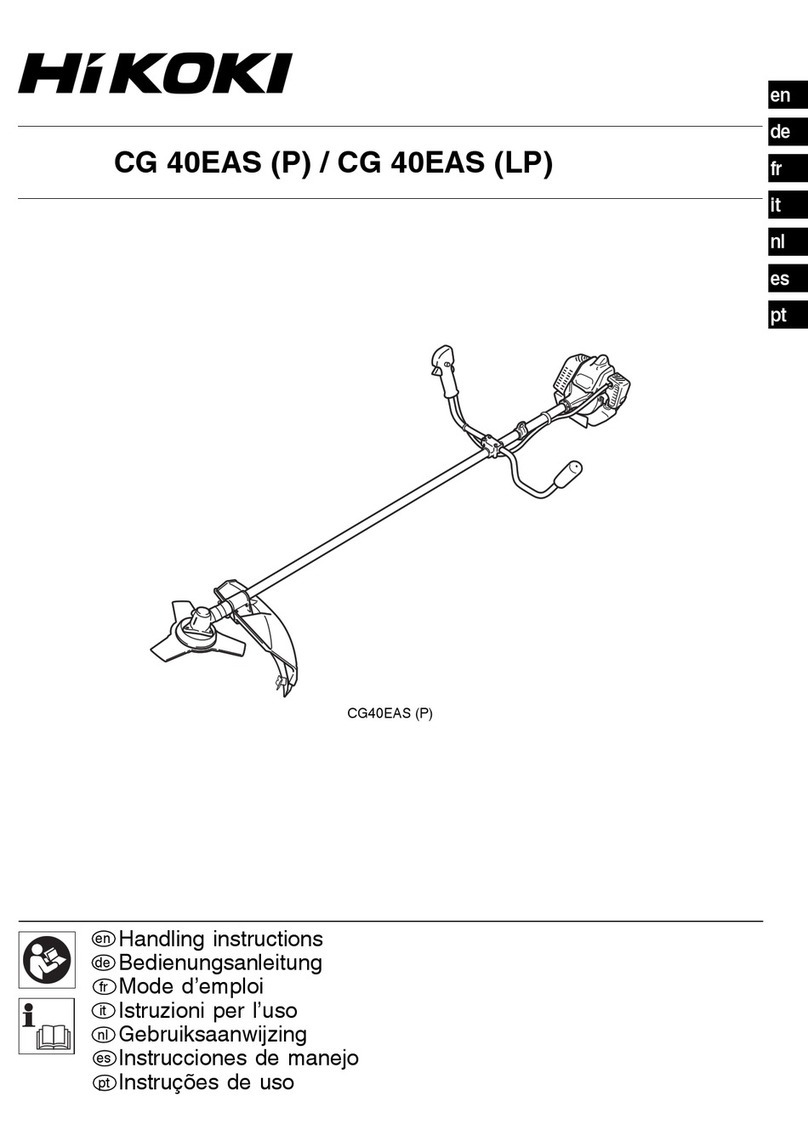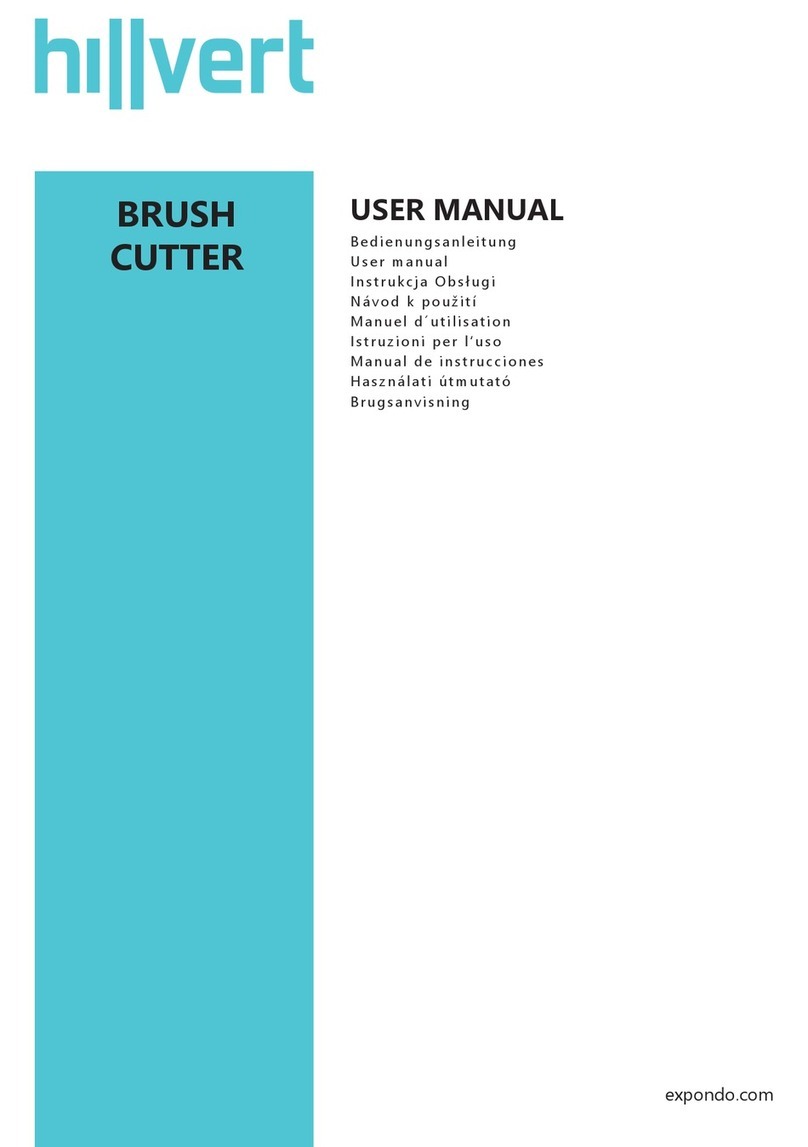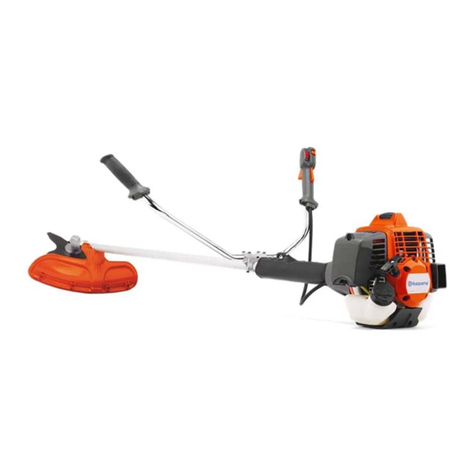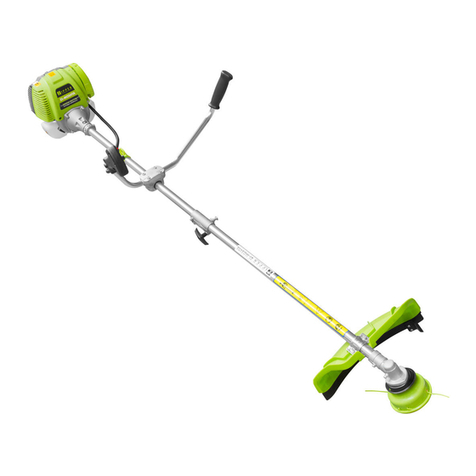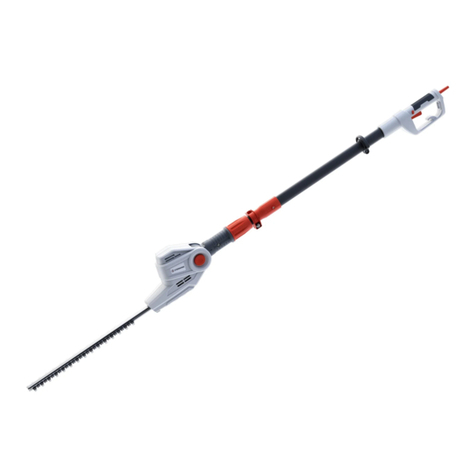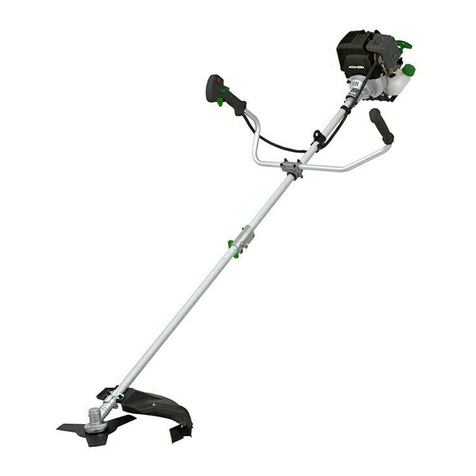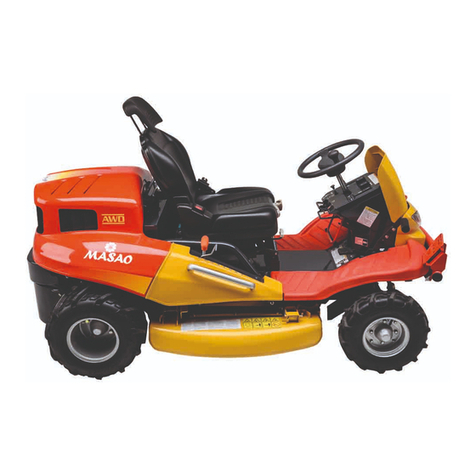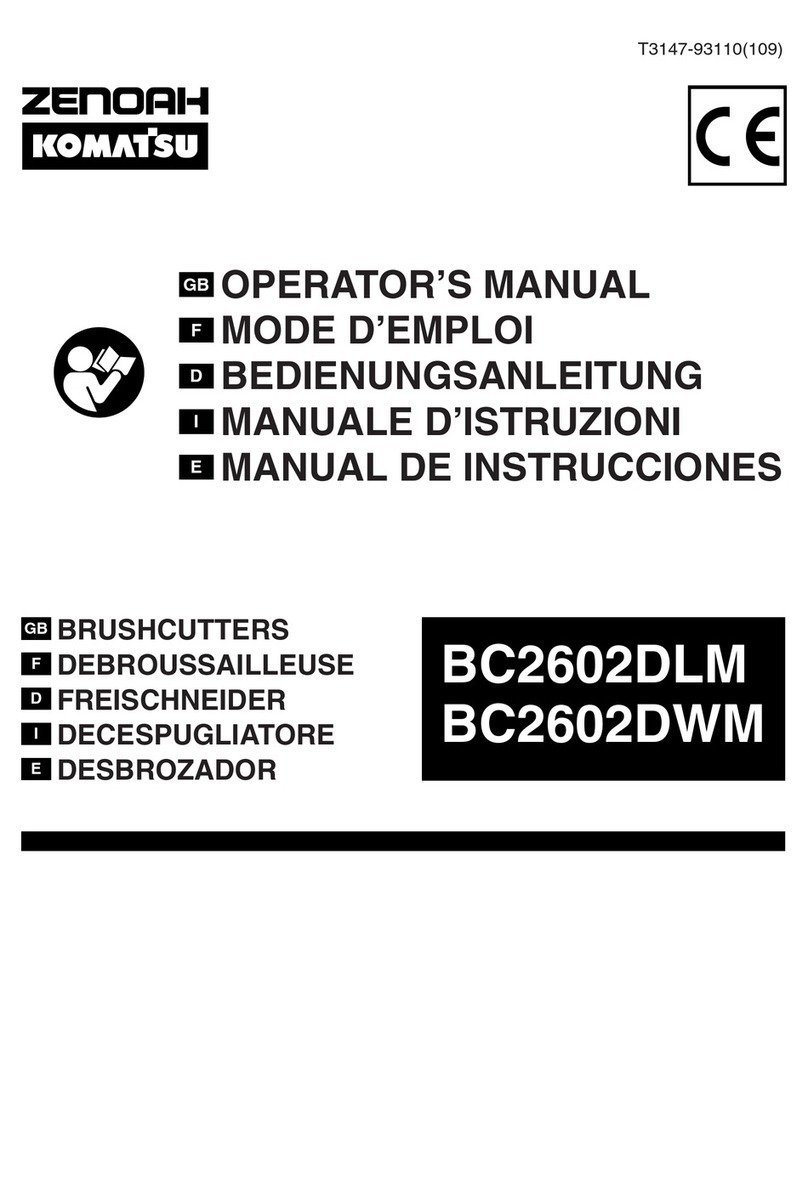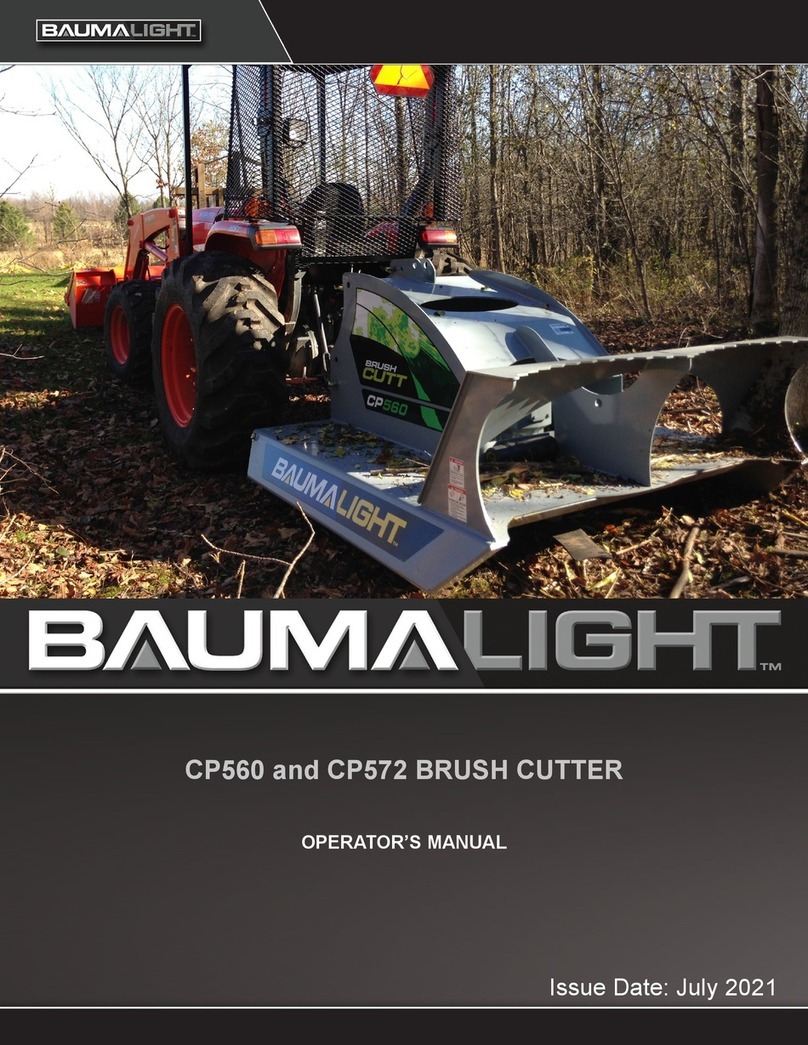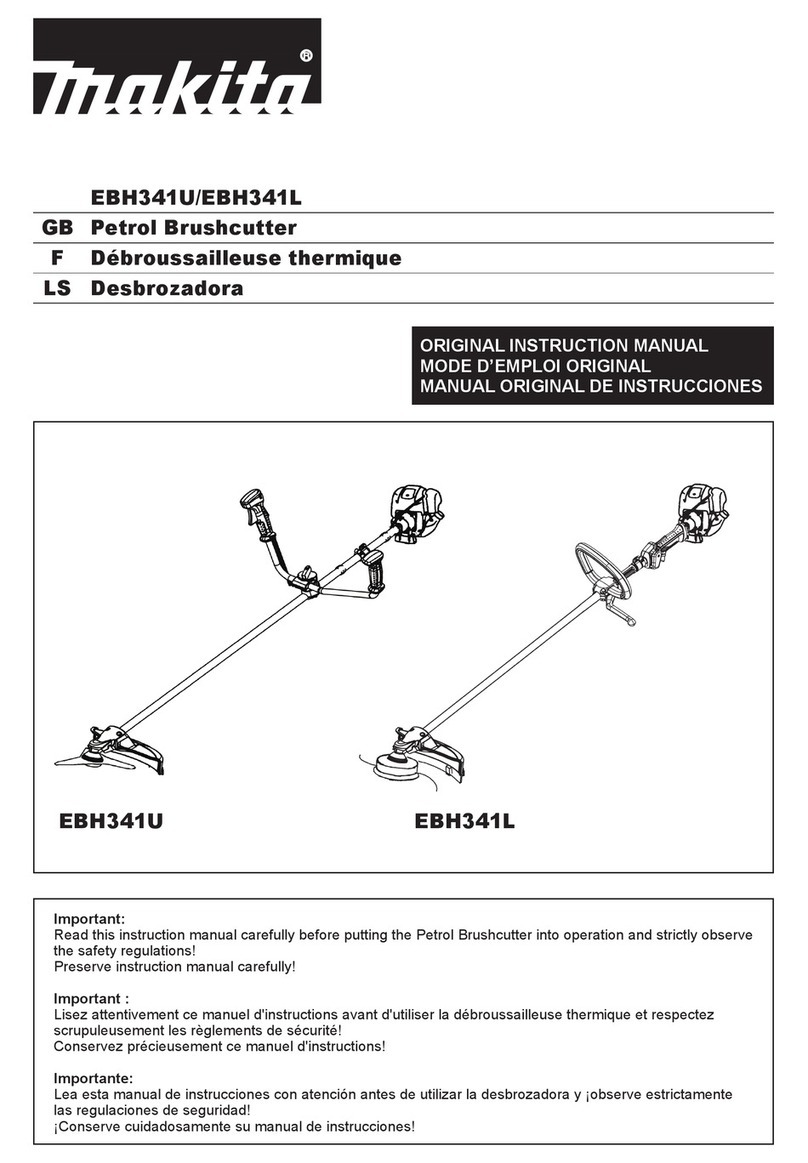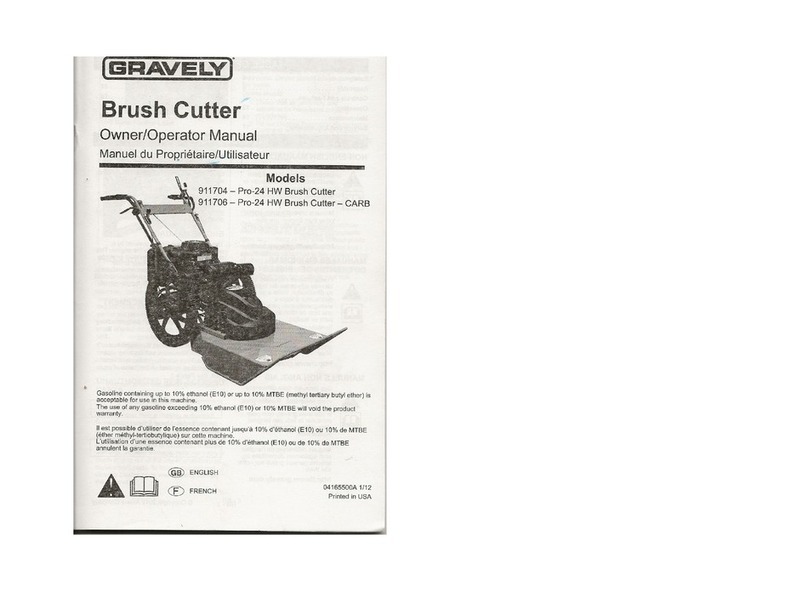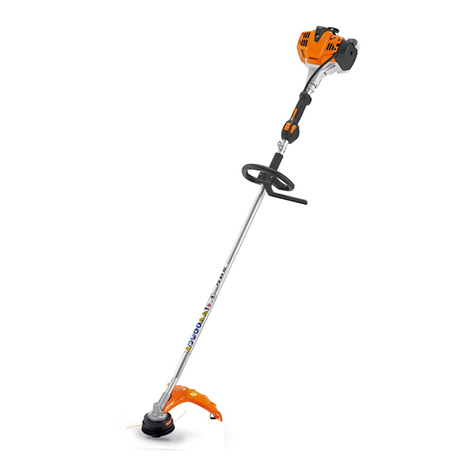HIKOKI CG 40EAS User manual

Brush Cutter
Desbrozadoras
Roçadeira
เครื่องตัดหญา
Read the manual carefully before operating this machine.
Antes de utilizar esta máquina, lea cuidadosamente el manual.
Leia o manual atentamente antes de operar esta máquina.
โปรดอานโดยละเอียดและทําความเขาใจกอนใชงาน
Handling instructions
Instrucciones de manejo
Instruções de uso
คูมือการใชงาน
CG 40EAS
000BookCG40EASSA.indb1000BookCG40EASSA.indb1 2018/03/309:15:402018/03/309:15:40

2
123
456
789
10
1
2
3
8
7
5
6
4
9
000BookCG40EASSA.indb2000BookCG40EASSA.indb2 2018/03/309:15:402018/03/309:15:40

3
11 12
13 14
15 16
17 18 19
16
17
10
11
12
15
14
13
000BookCG40EASSA.indb3000BookCG40EASSA.indb3 2018/03/309:15:402018/03/309:15:40

4
20 21 22
23 24 25
26 27 28
29 30 31
18
19
20 23 19
21
22
18
ab
T
24
13
000BookCG40EASSA.indb4000BookCG40EASSA.indb4 2018/03/309:15:412018/03/309:15:41

5
32 33 34
35 36 37
38 39 40
000BookCG40EASSA.indb5000BookCG40EASSA.indb5 2018/03/309:15:412018/03/309:15:41

6
English
MEANINGS OF SYMBOLS
NOTE: Some units do not carry them.
Symbols
WARNING
The following show symbols used for the machine. Be sure that you understand their meaning before use.
It is important that you read, fully
understand and observe the following
safety precautions and warnings.
Careless or improper use of the unit may
cause serious or fatal injury.
Shows maximum shaft speed. Do not
use the cutting attachment whose max
rpm is below the shaft rpm.
Read, understand and follow all warnings
and instructions in this manual and on
the unit.
Gloves should be worn when
necessary, e.g., when assembling
cutting equipment.
Always wear eye, head and ear protectors
when using this unit. Use anti-slip and sturdy footwear.
Keep all children, bystanders and helpers
15 m away from the unit. If anyone
approaches you, stop the engine and
cutting attachment immediately.
Blade thrust may occur when the
spinning blade contacts a solid object
in the critical area. A dangerous
reaction may occur causing the entire
unit and operator to be thrust violently.
This reaction is called blade thrust. As
a result, the operator may lose control
of the unit which may cause serious or
fatal injury. Blade thrust is more likely
to occur in areas where it is difficult to
see the material to be cut.
Be careful of thrown objects.
Contents
WHAT IS WHAT .................................................................................7
WARNINGS AND SAFETY INSTRUCTIONS ...................................8
SPECIFICATIONS .............................................................................9
ASSEMBLY PROCEDURES............................................................10
OPERATING PROCEDURES..........................................................10
MAINTENANCE...............................................................................11
000BookCG40EASSA.indb6000BookCG40EASSA.indb6 2018/03/309:15:422018/03/309:15:42

7
English
10
5
14
6
9
2
11
8
13
712
3
1
15
16
4
WHAT IS WHAT
Since this manual covers several models, there may be some
difference between pictures and your unit. Use the instructions that
apply to your unit.
1. Fuel cap
2. Throttle lever
3. Starter handle
4. Blade guard
5. Cutting attachment
6. Drive shaft tube
7. Han dle
8. Suspension eyelet
9. Ignition switch
10. Harness
11. Clutch case
12. Choke lever
13. Engine
14. Angle transmission
15. Combi box spanner
16. Handling instructions
000BookCG40EASSA.indb7000BookCG40EASSA.indb7 2018/03/309:15:422018/03/309:15:42

8
English
WARNINGS AND SAFETY INSTRUCTIONS
Operator safety
○Always wear a safety face shield or goggles.
○Always wear heavy, long pants, boots and gloves. Do not wear
loose clothing, jewelry, short pants, sandals or go barefoot.
Secure hair so it is above shoulder length.
○Do not operate this tool when you are tired, ill or under the
influence of alcohol, drugs or medication.
○Never let a child or inexperienced person operate the machine.
○Wear hearing protection. Pay attention to your surroundings.
Be aware of any bystanders who may be signaling a problem.
Remove safety equipment immediately upon shutting off
engine.
○Wear head protection.
○Never start or run the engine inside a closed room or building.
Breathing exhaust fumes can kill.
○Keep handles free of oil and fuel.
○Keep hands away from cutting equipment.
○Do not grab or hold the unit by the cutting equipment.
○When the unit is turned off, make sure the cutting attachment
has stopped before the unit is set down.
○When operation is prolonged, take a break from time to time
so that you may avoid possible Hand-Arm Vibration Syndrome
(HAVS) which is caused by vibration.
WARNING
○Antivibration systems do not guarantee that you will not sustain
Hand-Arm Vibration Syndrome or carpal tunnel syndrome.
Therefore, continual and regular users should monitor closely
the condition of their hands and fingers. If any symptoms of the
above appear, seek medical advice immediately.
○If you are using any medical electric/electronic devices such
as a pacemaker, consult your physician as well as the device
manufacturer prior to operating any power equipment.
Unit/machine safety
○Inspect the entire unit/machine before each use. Replace
damaged parts. Check for fuel leaks and make sure all
fasteners are in place and securely tightened.
○Replace parts that are cracked, chipped or damaged in any way
before using the unit/machine.
○Make sure the safety guard is properly attached.
○Keep others away when making carburetor adjustments.
○Use only accessories as recommended for this unit/machine by
the manufacturer.
WARNING
Never modify the unit/machine in any way. Do not use your unit/
machine for any job except that for which it is intended.
Fuel safety
○Mix and pour fuel outdoors and where there are no sparks or
flames.
○Use a container approved for fuel.
○Do not smoke or allow smoking near fuel or the unit/machine or
while using the unit/machine.
○Wipe up all fuel spills before starting engine.
○Move at least 3 m away from fueling site before starting engine.
○Stop engine before removing fuel cap.
○Empty the fuel tank before storing the unit/machine. It is
recommended that the fuel be emptied after each use. If fuel is
left in the tank, store so fuel will not leak.
○Store unit/machine and fuel in area where fuel vapors cannot
reach sparks or open flames from water heaters, electric motors
or switches, furnaces, etc.
WARNING
Fuel is easy to ignite or get explosion or inhale fumes, so that
pay special attention when handling or filling fuel.
Cutting safety
○Do not cut any material other than grass and brush.
○Inspect the area to be cut before each use. Remove objects
which can be thrown or become entangled.
○For respiratory protection, wear an aerosol protection mask
when cutting the grass after insecticide is scattered.
○Keep others including children, animals, bystanders and
helpers outside the 15 m hazard zone. Stop the engine
immediately if you are approached.
○Always keep the engine on the right side of your body.
○Hold the unit/machine firmly with both hands.
○Keep firm footing and balance. Do not over-reach.
○Keep all parts of your body away from the muffler and cutting
attachment when the engine is running.
○Keep cutting attachment below waist level.
○When relocating to a new work area, be sure to shut offthe
machine and ensure that all cutting attachments are stopped.
○Never place the machine on the ground when running.
○Always ensure that the engine is shut offand any cutting
attachments have completely stopped before clearing debris or
removing grass from the cutting attachment.
○Always carry a first-aid kit when operating any power
equipment.
○Never start or run the engine inside a closed room or building
and/or near inflammable liquids. Breathing exhaust fumes can
kill.
Maintenance safety
○Maintain the unit/machine according to recommended
procedures.
○Disconnect the spark plug before performing maintenance
except for carburetor adjustments.
○Keep others away when making carburetor adjustments.
○Use only genuine HiKOKI replacement parts as recommended
by the manufacturer.
Transport and storage
○Carry the unit/machine by hand with the engine stopped and
the muffler away from your body.
○Allow the engine to cool, empty the fuel tank, and secure the
unit/machine before storing or transporting in a vehicle.
○Empty the fuel tank before storing the unit/machine. It is
recommended that the fuel be emptied after each use. If fuel is
left in the tank, store so fuel will not leak.
○Store unit/machine out of the reach of children.
○Clean and maintain the unit carefully and store it in a dry place.
○Make sure engine switch is offwhen transporting or storing.
○When transporting in a vehicle, cover blade with blade cover.
If situations occur which are not covered in this manual, take care
and use common sense. Contact your HiKOKI dealer if you need
assistance. Pay special attention to statements preceded by the
following words:
WARNING
Indicates a strong possibility of severe personal injury or loss of
life, if instructions are not followed.
CAUTION
Indicates a possibility of personal injury or equipment damage,
if instructions are not followed.
NOTE
Helpful information for correct function and use.
CAUTION
Do not disassemble the recoil starter. You may get a possibility
of personal injury with recoil spring.
000BookCG40EASSA.indb8000BookCG40EASSA.indb8 2018/03/309:15:422018/03/309:15:42

9
English
SPECIFICATIONS
Model CG40EAS
Engine Size (ml) 39.8
Spark Plug NGK BPMR6A or equivalent
Fuel Tank Capacity (l) 1.00
Dry Weight (kg) 7.5
Sound pressure level
LpA (dB (A))
(EN27917)
90
Measured sound power level LwA
(dB (A))
Guaranteed sound power level LwA
(dB (A))
108.8
110
105
110
Vibration level (m/s2) (ISO7916)
Front handle
Rear handle
Left handle
Right handle
—
—
3.4
3.4
—
—
5.5
5.3
NOTE
Equivalent noise level/vibration level are calculated as the time-weighted energy total for noise/vibration levels under various working
conditions with the following time distribution: 1/2 Idle, 1/2 racing.
* All data is subject to change without notice.
000BookCG40EASSA.indb9000BookCG40EASSA.indb9 2018/03/309:15:422018/03/309:15:42

10
English
ASSEMBLY PROCEDURES
Drive shaft to engine (Fig. 1)
Loosen tube locking bolt (1) about ten turns so that the bolt point will
not obstruct drive shaft tube to be inserted. When inserting drive
shaft tube, hold the tube locking bolt outward preventing inside
fitting from obstructing as well.
Some models may come with the drive shaft already installed.
NOTE
When it is hard to insert drive shaft up to the marked position on
the drive shaft tube, turn drive shaft by the cutter mounting end
clockwise or counter-clockwise. Tighten tube locking bolt lining
up the hole in the shaft tube. Then tighten clamp bolt securely
(1).
Installation of handle
Remove the handle bracket (2) from the assembly. (Fig. 2)
Place the handles and attach the handle bracket with four bolts
lightly. Adjust to appropriate position. Then attach it firmly with the
bolts.
Attach the protection tube to the drive shaft or handle using cord
clamps (3). (Fig. 3)
NOTE
If the protection tube is set apart from the handle or pipe, it will
be caught by something during operation and it may cause
serious injury. Do not set the protection tube apart from the
handle or pipe.
Throttle wire / stop cord
Remove air cleaner cover. (Fig. 4)
Connect stop cords. (Fig. 5)
Insert the stay (4) under the nut (5) screwed onto the outer end of
the throttle wire (6) and connect the end of the throttle wire (7) to the
carburetor (8). Then tighten the nut (5) to secure the throttle wire to
the stay (4). (Fig. 6)
NOTE
Check that the carburetor throttle returns to the idle position
and also that it can be opened wide by operating the throttle
lever.
Cover throttle wire and stop cords together with protective tube
provided up to air cleaner cover. (Fig. 7)
Some models may come with the drive shaft already installed.
Installation of blade guard (Fig. 8)
The guard bracket already mounted to the drive shaft tube.
Install the blade guard on drive shaft tube against angle
transmission (9). Tighten the guard bracket firmly so that the blade
guard does not swing or move down during operation.
CAUTION
The blade guard must be in place during operation.
If the blade guard is not in place, there is a possibility of serious
injury.
Blade guards are equipped with sharp line limiter. Be careful with
handling it.
NOTE
○When attaching the guard extension to the blade guard, the
sharp line limiter must be removed from the blade guard.
○To remove the guard extension, refer to the drawings. Wear
gloves as the extension has a sharp line limiter, then push the
two square tabs on the guard one by one in order after removed
the screw. (Fig. 10)
Installation of cutting blade (Fig. 11)
When installing a cutting blade, make sure that there are no cracks
or any damage in it and that the cutting edges are facing the correct
direction.
Align the notch hole of the cutter holder with the hole on the gear
case (Top the gear case) and insert the Allen wrench to stop
turning. Turn the fixing nut clockwise and remove the fixing nut,
protection cover, cutter holder cap, and toothed lock washers.
The installation of the cutting blade is as follows: insert the Allen
wrench into the notch hole of the cutter holder and the hole on
the gear case. Then, install the cutting blade (check the installing
direction, as referring to Fig. 13), the cutter holder cap, protection
cover and toothed lock washers onto the cutter holder in this order.
Finally, tighten the fixing nut securely by turning counterclockwise
with the Combi box spanner. (Fig. 11)
CAUTION
○When installing the cutting blade, set its center hole to the
convex part of the cutter holder and hold it with the concave
surface of the cutter holder cap. Then, tighten the fixing nut to
prevent the cutting blade from being eccentric. (Fig. 11)
After installing the cutting blade, be sure to remove the Allen
wrench and Combi box spanner.
○Before operation, make sure the blade has been properly
installed.
○Before operation, check the cutter holder cap under the cutting
blade for wear or cracks. If any damage or wear is found,
replace it, as it is an article of consumption.
NOTE
The blade must be retained with a new cotter pin each time
installed. (Fig. 11)
Installation of nylon head
Attach cutter holder (10) to the gear case. Insert an Allen wrench
into the hole in the gear case to attach winding protector (11) and
attach nylon head (12) by turning it clockwise.
NOTE
Since cutter holder cap is not used here, keep it for next metal
blade use.
OPERATING PROCEDURES
Fuel (Fig. 15)
WARNING
○The brush cutter is equipped with a two-stroke engine. Always
run the engine on fuel, which is mixed with oil.
Provide good ventilation, when fueling or handling fuel.
○Fuel is highly flammable and toxic and can result in serious
injury if it is inhaled or comes into contact with your skin. Always
handle fuel with care. Always have good ventilation when
handling fuel inside building.
Fuel
○Always use branded 89 octane unleaded gasoline.
○Use genuine two-cycle oil or use a mix between 25:1 to 50:1,
please consult the oil bottle for the ratio or HiKOKI dealer.
○If genuine oil is not available, use an anti-oxidant added quality
oil expressly labeled for air-cooled 2-cycle engine use (JASO
FC GRADE OIL or ISO EGC GRADE). Do not use BIA or TCW
(2-stroke water-cooling type) mixed oil.
○Never use multi-grade oil (10 W/30) or waste oil.
○Always mix fuel and oil in a separate clean container.
Always start by filing half the amount of fuel, which is to be used.
Then add the whole amount of oil. Mix (shake) the fuel mixture. Add
the remaining amount of fuel.
Mix (shake) the fuel-mix thoroughly before filling the fuel tank.
Fueling
WARNING
○Always shut offthe engine before refueling.
○Slowly open the fuel tank, when filling up with fuel, so that
possible over-pressure disappears.
○Tighten the fuel cap carefully, after fueling.
000BookCG40EASSA.indb10000BookCG40EASSA.indb10 2018/03/309:15:422018/03/309:15:42

11
English
○Always move the brush cutter at least 3 m from the fueling area
before starting.
○Always wash any spilled fuel from clothing immediately with
soap.
○Be sure to check for any fuel leakage after refueling.
Before fueling, clean the tank cap area carefully, to ensure that
no dirt falls into the tank. Make sure that the fuel is well mixed by
shaking the container, before fueling.
Starting (Fig. 16)
CAUTION
Before starting, make sure the cutting attachment does not
touch anything.
1. Slide ignition switch (13) to RUN position. (Fig. 16)
* Push priming bulb (16) several times so that fuel flows through
return pipe. (Fig. 17)
2. With the safety trigger (14) (if so equipped) pressed, pull
throttle trigger and push throttle lock (15). Then slowly release
the throttle trigger first, then the safety trigger. This will lock the
throttle in starting position.
3. Set choke lever to CLOSED position (17). (Fig. 18)
4. Pull recoil starter briskly, taking care to keep the handle in your
grasp and not allowing it to snap back. (Fig. 19)
5. When you hear the engine want to start, return choke lever to
RUN position (open). Then pull recoil starter briskly again.
NOTE
If engine does not start, repeat procedures from 2 to 5.
6. After starting engine, pull throttle trigger to release throttle lock.
Then allow the engine about 2–3 minutes to warm up before
subjecting it to any load.
Cutting (Fig. 20, 21, 22)
○When cutting, operate engine at over 6500 rpm. Extended time
of use at low rpm may wear out the clutch prematurely.
○Cut grass from right to left.
○Blade thrust may occur when the spinning blade contacts a
solid object in the critical area.
A dangerous reaction may occur causing the entire unit and
operator to be thrust violently. This reaction is called blade
thrust. As a result, the operator may lose control of the unit
which may cause serious or fatal injury. Blade thrust is more
likely to occur in areas where it is difficult to see the material to
be cut.
○Wear the harness as shown in the figure. The blade turns
counter-clockwise, therefore, be advised to operate the unit
from right to left for efficient cutting. Keep onlookers out of
working area at least 15 m.
NOTE
Press the quick release button or pull emergency release flap in
the event of emergency. (Fig. 23)
How to use the shoulder harness
Wear the shoulder harness on your shoulder as shown Fig. 21
and hook it on the hanger of the machine. Adjust the length of the
shoulder harness to the most comfortable position. (Fig. 21)
To remove the machine from the shoulder harness, hold the main
pipe of the machine firmly by one hand and then remove the hook
(19) of the shoulder harness from the hanger (20). (Fig. 23-a)
How to reinstall the hook after using the emergency release
pinch
It needs to go through the buckle (21) of the hook (19) to the metal
plate (22) on the harness and go through the plate (23) of the
emergency release pinch to the metal plate (22) on the harness.
(Fig. 23-b)
After installing the buckle onto the harness, pull the hook (19) and
make sure the hook (19) is securely fixed on the harness, then hook
it to the hanger (20). (Fig. 23-a)
WARNING
○When using the machine, wear the shoulder harness and hold
the machine correctly with both hands.
If you feel that there is something dangerous, separate the
brush cutter from your body by pulling the emergency release
pinch (18) of the harness to the direction of the arrow shown in
Fig. 23-a.
○If the cutting attachment should strike stones or other debris,
stop the engine and make sure that the attachment and related
parts are undamaged. When grass or vines wrap around
attachment, stop engine and attachment and remove them.
NOTE
If you pull the emergency release pinch without holding the
machine, the machine will fall to your feet. Pull the emergency
release pinch while holding the main pipe of the machine by
one hand.
Before operation, make sure that the emergency release pinch
on the shoulder harness is working properly.
Stopping (Fig. 24)
Decrease engine speed and run at an idle for a few minutes, then
turn offignition switch (13).
WARNING
A cutting attachment can injure while it continues to spin after
the engine is stopped or power control is released. When the
unit is turned off, make sure the cutting attachment has stopped
before the unit is set down.
How to use nylon head
When cutting, operate engine at over 6500 rpm. Extended use at
low rpm may wear out the clutch prematurely.
This product is designed so that it will stop cutting when the nylon
line becomes 16 cm or longer.
WARNING
A cutting attachment can injure while it continues to spin after
the engine is stopped or power control is released. When the
unit is turned off, make sure the cutting attachment has stopped
before the unit is set down.
Set the engine speed as low as possible and tap the Head on the
ground. (Fig. 25) Also, you can extend nylon line with hands but the
engine must be completely stopped. (Fig. 26)
Adjust nylon line to proper length 11–14 cm before each operation.
MAINTENANCE
MAINTENANCE, REPLACEMENT OR REPAIR OF THE EMISSION
CONTROL DEVICES AND SYSTEMS MAY BE PERFORMED
BY ANY NON-ROAD ENGINE REPAIR ESTABLISHMENT OR
INDIVIDUAL.
Carburetor adjustment (Fig. 27)
WARNING
○The cutting attachment may be spinning during carburetor
adjustments.
○Never start the engine without the complete clutch cover and
tube assembled! Otherwise the clutch can come loose and
cause personal injuries.
In the carburetor, fuel is mixed with air. When the engine is test
run at the factory, the carburetor is basically adjusted. A further
adjustment may be required, according to climate and altitude. The
carburetor has one adjustment possibility:
T = Idle speed adjustment screw.
Idle speed adjustment (T)
Check that the air filter is clean. When the idle speed is correct, the
cutting attachment will not rotate. If adjustment is required, close
(clockwise) the T-screw, with the engine running, until the cutting
attachment starts to rotate. Open (counter-clockwise) the screw
until the cutting attachment stops. You have reached the correct idle
speed when the engine runs smoothly in all positions well below the
rpm when the cutting attachment starts to rotate.
If the cutting attachment still rotates after idle speed adjustment,
contact your HiKOKI dealer.
000BookCG40EASSA.indb11000BookCG40EASSA.indb11 2018/03/309:15:422018/03/309:15:42

12
English
NOTE
Standard Idle rpm is 2500–3000 rpm.
WARNING
When the engine is idling the cutting attachment must under no
circumstances rotate.
Air filter (Fig. 28)
The air filter must be cleaned from dust and dirt in order to avoid:
○Carburetor malfunctions
○Starting problems
○Engine power reduction
○Unnecessary wear on the engine parts
○Abnormal fuel consumption
Clean the air filter daily or more often if working in exceptionally
dusty areas.
Cleaning the air filter
Remove the air filter cover and the filter (24). Rinse it in warm soap
suds. Check that the filter is dry before reassembly. An air filter
that has been used for some time cannot be cleaned completely.
Therefore, it must regularly be replaced with a new one. A damaged
filter must always be replaced.
Fuel filter (Fig. 29)
Drain all fuel from fuel tank and pull fuel filter line from tank. Pull
filter element out of holder assembly and rinse element in warm
water with detergent.
Rinse thoroughly until all traces of detergent are eliminated.
Squeeze, do not wring, away excess water and allow element to air
dry.
NOTE
If element is hard due to excessive dirt buildup, replace it.
Spark plug (Fig. 30)
The spark plug condition is influenced by:
○An incorrect carburetor setting
○Wrong fuel mixture (too much oil in the gasoline)
○A dirty air filter
○Hard running conditions (such as cold weather)
These factors cause deposits on the spark plug electrodes, which
may result in malfunction and starting difficulties. If the engine
is low on power, difficult to start or runs poorly at idling speed,
always check the spark plug first. If the spark plug is dirty, clean it
and check the electrode gap. Re-adjust if necessary. The correct
gap is 0.6 mm. The spark plug should be replaced after about 100
operation hours or earlier if the electrodes are badly eroded.
Muffler (Fig. 31)
Remove the muffler and clean out any excess carbon from the
exhaust port or muffler inlet every 100 hours of operation.
Cylinder (Engine cooling) (Fig. 32)
The engine is air cooled, and air must circulate freely around engine
and over cooling fins on cylinder head to prevent overheating.
Every 100 operating hours, or once a year (more often if conditions
require), clean fins and external surfaces of engine of dust, dirt and
oil deposits which can contribute to improper cooling.
NOTE
Do not operate engine with engine shroud or muffler guard
removed as this will cause overheating and engine damage.
Angle transmission (Fig. 33)
Check angle transmission or angle gear for grease level about every
50 hours of operation by removing the grease filler plug on the side
of angle transmission.
If no grease can be seen on the fl
anks of the gears, fill the
transmission with quality lithium based multipurpose grease up to
3/4. Do not completely fill the transmission.
Blade
WARNING
Wear protective gloves when handling or performing
maintenance on the blade. (Fig. 34)
○Use a sharp blade. A dull blade is more likely to snag and thrust.
Replace the fastening nut if it is damaged and hard to tighten.
○When replacing blade, purchase one recommended by
HiKOKI, with a 25.4 mm (one inch) fitting hole.
○When installing a saw blade, always face the stamped side up.
In the case of a 3 tooth blade, it can be used on either side.
○Use the correct blade for the type of work.
○When replacing blades, use appropriate tools.
○When cutting edges become dull, re-sharpen or file as shown
in the illustration. Incorrect sharpening may cause excessive
vibration.
○Discard blades that are bent, warped, cracked, broken or
damaged in any way.
NOTE
When sharpening blade it is important to maintain an original
shape of radius at the base of the tooth to avoid cracking.
Nylon head
Nylon line replacement
○Remove the cutting body cap by pushing inward the locking
tabs on the side of the nylon head (Fig. 35). Take out the spool
(Fig. 36), hook the new nylon line into the hole of the spool, then
wind it around the spool (Fig. 37).
When the nylon line has been wound around the spool,
temporarily fasten it in the opening of the spool at about 10 cm
from the end. (Fig. 38) Then thread the nylon line through the
hole on the side of the nylon head and place the cutting body
cap in reverse order of the cap removal. Pull the right and left
nylon lines until they are secured about 15 – 16 cm from the end.
(Fig. 40)
NOTE
○The nylon head is designed for nylon lines with an outer
diameter of 2.5 mm. Do not use nylon lines with a different outer
diameter.
○Make sure that the right and left nylon lines are of equal length
since vibrations will otherwise increase.
Maintenance schedule
Below you will find some general maintenance instructions. For
further information please contact your HiKOKI dealer.
Daily maintenance
○Clean the exterior of the unit.
○Check that the harness is undamaged.
○Check the blade guard for damage or cracks. Change the guard
in case of impacts or cracks.
○Check that the cutting attachment is properly centred, sharp,
and without cracks. An off-centre cutting attachment induces
heavy vibrations that may damage the unit.
○Check that the cutting attachment nut is sufficiently tightened.
○Make sure that the blade transport guard is undamaged and
that it can be securely fitted.
○Check that nuts and screws are sufficiently tightened.
Weekly maintenance
○Check the starter, especially the cord and return spring.
○Clean the exterior of the spark plug.
○Remove it and check the electrode gap. Adjust it to 0.6 mm, or
change the spark plug.
○Clean the cooling fins on the cylinder and check that the air
intake at the starter is not clogged.
○Check that the angle gear is filled with grease up to 3/4.
○Clean the air filter.
Monthly maintenance
○Rinse the fuel tank with gasoline.
○Clean the exterior of the carburetor and the space around it.
○Clean the fan and the space around it.
000BookCG40EASSA.indb12000BookCG40EASSA.indb12 2018/03/309:15:422018/03/309:15:42

13
Español
SIGNIFICADO DE LOS SÍMBOLOS
NOTA: Algunos aparatos no están provistos de ellos.
Símbolos
ADVERTENCIA
A continuación se muestran los símbolos usados para la máquina. Asegúrese de comprender su significado
antes del uso.
Es importante que usted lea, entienda
totalmente y observe las siguientes
precauciones y advertencias de seguridad.
El uso descuidado o incorrecto del aparato
podrá causarle lesiones serias o fatales.
Muestra la velocidad máxima del eje.
No utilice mecanismos de corte cuyas
rpm máximas sean inferiores a las
rpm del eje.
Lea, comprenda y siga todas las
advertencias y demás instrucciones de
este manual y las que se muestran en el
aparato.
Deben utilzarse guantes siempre que
sea necesario, por ejemplo, cuando se
monten equipos de corte.
Utilice siempre protecciones para los ojos,
la cabeza y los oídos cuando utilice este
aparato.
Utilice calzado antideslizante y
resistente.
Haga que los niños, sus ayudantes o
cualquier otra persona se mantengan a una
distancia de 15 m del aparato. Si alguien
se acerca a usted, detenga el motor y el
mecanismo de corte de inmediato.
Puede producirse una sacudida
de la cuchilla si al encontrarse en
movimiento ésta entra en contacto
con un objeto sólido en la zona crítica.
Puede producirse una reacción
peligrosa que sacuda violentamente el
aparato y al usuario. Esta reacción se
conoce como sacudida de la cuchilla.
Como consecuencia, el usuario
podría perder el control de la unidad
y ocasionar lesiones graves e incluso
mortales. Existen más probabilidades
de que se produzcan sacudidas de la
cuchilla en zonas en las que es difícil
ver el material que se está cortando.
Tenga cuidado con los objetos que puedan
salir despedidos.
Contenido
¿QUÉ ES QUÉ? ...............................................................................14
ADVERTENCIAS E INSTRUCCIONES DE SEGURIDAD ..............15
ESPECIFICACIONES ......................................................................16
PROCEDIMIENTOS DE MONTAJE ................................................17
PROCEDIMIENTOS DE OPERACIÓN............................................17
MANTENIMIENTO...........................................................................19
000BookCG40EASSA.indb13000BookCG40EASSA.indb13 2018/03/309:15:422018/03/309:15:42

14
Español
10
5
14
6
9
2
11
8
13
712
3
1
15
16
4
¿QUÉ ES QUÉ?
Puesto que este manual cubre varios modelos, puede que existan
diferencias entre los dibujos y su unidad. Utilice las instrucciones
que se refieran a su unidad.
1. Tapa del depósito de combustible
2. Mango del acelerador
3. Mango del arrancador
4. Protector de la cuchilla
5. Mecanismo de corte
6. Eje de transmisión
7. Asi dero
8. Ojal de la suspensión
9. Llave de ignición
10. Arnés
11. Carcasa del embrague
12. Palanca del estárter
13. Motor
14. Transmisión en ángulo
15. Llave combinada de cubo
16. Instrucciones de manejo
000BookCG40EASSA.indb14000BookCG40EASSA.indb14 2018/03/309:15:422018/03/309:15:42

15
Español
ADVERTENCIAS E INSTRUCCIONES DE
SEGURIDAD
Seguridad del usuario
○Utilice siempre protecciones como caretas o gafas de
seguridad.
○ Utilice siempre pantalones largos, botas y guantes de tejidos
resistentes. No utilice prendas sueltas, joyas, pantalones
cortos o sandalias, y nunca trabaje descalzo. Recójase el pelo
de forma que quede por encima del hombro.
○No opere este aparato si está cansado, enfermo o bajo la
influencia del alcohol, drogas o medicamentos.
○No deje que niños o personas inexpertas operen el aparato.
○Utilice protección para los oídos. Preste atención a su entorno.
Esté atento a personas que pudieran estar avisándole de un
problema. Quítese el equipo de seguridad inmediatamente
después de detener el motor.
○Utilice casco protector.
○Nunca encienda el motor o haga funcionar el aparato dentro de
una sala cerrada o un edificio. La inhalación de los gases de
escape puede ser mortal.
○Mantenga los asideros libres de aceite y combustible.
○Mantenga las manos alejadas del equipo de corte.
○No agarre o sostenga el aparato por el equipo de corte.
○Cuando el aparato esté apagado, asegúrese de que el
mecanismo de corte se ha detenido antes de apoyarlo sobre el
suelo.
○Durante periodos de operación prolongados, se recomienda
descansar de vez en cuando para evitar el posible síndrome
de vibración de manos y brazos (HAVS) causado por las
vibraciones.
ADVERTENCIA
○Los sistemas antivibratorios no garantizan que pudiera verse
afectado por síndrome de vibración de manos y brazos o el
síndrome del túnel carpiano. Por lo tanto, los usuarios que
utilicen el aparato asiduamente o con regularidad deberán
vigilar con atención el estado de sus manos y dedos. Si
aparece cualquiera de los síntomas citados, deberá acudirse a
un médico de inmediato.
○Si utiliza algún dispositivo médico eléctrico o electrónico,
como por ejemplo un marcapasos, consulte a su médico y al
fabricante del dispositivo antes de operar cualquier equipo
motorizado.
Seguridad del aparato
○Inspeccione siempre el aparato antes de utilizarlo.
Reemplace las piezas dañadas. Compruebe que no hay
fugas de combustible y asegúrese de que todas las piezas se
encuentran en su sitio y han sido apretadas correctamente.
○Reemplace cualquier pieza agrietada, rota o deteriorada antes
de poner en marcha el aparato.
○Asegúrese de que la protección de seguridad está acoplada
correctamente.
○No permita que se acerquen personas mientras ajusta el
carburador.
○Utilice únicamente los accesorios que el fabricante recomiende
para este dispositivo.
ADVERTENCIA
No intente modificar el aparato en forma alguna. No utilice este
aparato para otras tareas para las que no esté indicado.
Seguridad del combustible
○Mezcle y llene el combustible al aire libre, en lugares donde no
se produzcan chispas ni llamas.
○Utilice un recipiente homologado para combustible.
○No fume ni deje fumar a otras personas en las proximidades
del combustible o del aparato mientras éste se encuentre en
marcha.
○Limpie los restos de combustible antes de arrancar el motor.
○Antes de arrancar el motor, desplácese al menos 3 metros
respecto del lugar en el que ha llenado el combustible.
○Detenga el motor antes de quitar la tapa del depósito de
combustible.
○Vacíe el depósito de combustible antes de guardar el aparato.
Se recomienda vaciar el depósito de combustible cada vez
que termine de utilizar el aparato. Si deja combustible en el
depósito, asegúrese de que no van a producirse escapes.
○Guarde el aparato y el combustible en un lugar donde los
vapores del combustible no puedan entrar en contacto con
chispas o llamas de calentadores de agua, motores eléctricos,
interruptores, hornos, etc.
ADVERTENCIA
El combustible puede inflamarse, explotar o emitir gases con
facilidad. Por lo tanto, debe prestar especial atención cuando
manipule o recargue el combustible.
Seguridad durante el corte
○No corte ningún material que no sea hierba o maleza.
○Inspeccione siempre la zona sobre la que va a cortar antes de
comenzar. Retire cualquier objeto que pueda salir despedido o
enredarse.
○Para proteger las vías respiratorias, utilice una máscara de
protección contra aerosoles cuando corte hierba tras haber
fumigado con insecticidas.
○Mantenga a otras personas, niños, animales y ayudantes
a una distancia de 15 m de la zona de riesgo. Detenga
inmediatamente el motor si se le acerca alguna persona.
○Mantenga el motor en el lado derecho respecto de su cuerpo
en todo momento.
○Sostenga el aparato firmemente con ambas manos.
○Apoye sus pies con firmeza y mantenga el equilibrio. No estire
demasiado el cuerpo.
○Mantenga su cuerpo apartado del silenciador y del mecanismo
de corte mientras el motor se encuentra en marcha.
○Mantenga el mecanismo de corte por debajo del nivel de la
cintura.
○Cuando cambie de zona de trabajo, asegúrese de detener el
aparato y de que el mecanismo de corte se ha detenido.
○Nunca deposite el aparato sobre el suelo mientras éste se
encuentra en marcha.
○Asegúrese siempre de que el motor está apagado y de que
el mecanismo de corte se ha detenido por completo antes de
eliminar residuos o hierba del mecanismo de corte.
○Lleve siempre un botiquín de primeros auxilios consigo cuando
opere cualquier equipo motorizado.
○Nunca encienda el motor o haga funcionar el aparato dentro de
una sala cerrada o un edificio o en las proximidades de líquidos
inflamables. La inhalación de los gases de escape puede ser
mortal.
Seguridad durante el mantenimiento
○Realice el mantenimiento del aparato siguiendo los
procedimientos recomendados.
○Antes de realizar el mantenimiento, desconecte la bujía (salvo
si va a ajustar el carburador).
○No permita que se acerquen personas mientras ajusta el
carburador.
○Utilice únicamente los repuestos y accesorios originales de
HiKOKI recomendados.
Transporte y almacenamiento
○Transporte el aparato con el motor y el silenciador a una
distancia segura del cuerpo.
○Antes de almacenar o transportar el aparato en un vehículo,
espere a que se haya enfriado el motor, vacíe el depósito de
combustible y asegúrelo correctamente.
○Vacíe el depósito de combustible antes de guardar el aparato.
Se recomienda vaciar el depósito de combustible cada vez
que termine de utilizar el aparato. Si deja combustible en el
depósito, asegúrese de que no van a producirse escapes.
○Guarde el aparato lejos del alcance de niños.
○Limpie y lleve a cabo el mantenimiento del aparato con cuidado
y guárdelo en un lugar seco.
○Asegúrese de que la llave de encendido del motor esté
desconectada cuando transporte o guarde el aparato.
○Cuando transporte el aparato en un vehículo o lo guarde, cubra
la cuchilla con una cubierta.
000BookCG40EASSA.indb15000BookCG40EASSA.indb15 2018/03/309:15:422018/03/309:15:42

16
Español
ESPECIFICACIONES
Modelo CG40EAS
Tamaño del motor (ml) 39,8
Bujía NGK BPMR6A o equivalente
Capacidad del depósito de
combustible (l) 1,00
Peso en seco (kg) 7,5
Nivel de presión sonora
LpA (dB (A))
(EN27917)
90
Nivel de potencia correcta medida LwA
(dB (A))
Nivel de potencia correcta garantizada
LwA (dB (A))
108,8
110
105
110
Nivel vibratorio (m/s2) (ISO7916)
Asidero frontal
Asidero trasero
Asidero izquierdo
Asidero derecho
—
—
3,4
3,4
—
—
5,5
5,3
NOTA
Los niveles de ruido/vibración equivalentes se calculan como la energía ponderada en base al tiempo en distintas condiciones de
trabajo con la siguiente distribución de tiempo: 1/2 ralentí, 1/2 a potencia.
* Todos los datos están sujetos a cambios sin previo aviso.
Si se producen situaciones no previstas en este manual, utilice el
sentido común. Póngase en contacto con su distribuidor de HiKOKI
si necesita ayuda. Dedique especial atención a los apartados
introducidos por las siguientes palabras:
ADVERTENCIA
Indica un riesgo significativo de que se produzcan daños
personales graves e incluso la muerte si no se siguen las
instrucciones.
PRECAUCIÓN
Indica la posibilidad de que se produzcan daños personales o
materiales si no se siguen las instrucciones.
NOTA
Indica información útil para el uso y correcto funcionamiento
del aparato.
PRECAUCIÓN
No desmonte el arrancador de retroceso. El resorte del
arrancador puede ocasionarle lesiones personales graves.
000BookCG40EASSA.indb16000BookCG40EASSA.indb16 2018/03/309:15:422018/03/309:15:42

17
Español
PROCEDIMIENTOS DE MONTAJE
Eje de distribución a motor (Fig. 1)
Afloje el tornillo de bloqueo del tubo (1) aproximadamente diez
vueltas de manera que el punto del tornillo no impida que pueda
insertarse el tubo del eje de distribución. Cuando inserte el tubo del
eje de distribución, mantenga el tornillo de bloqueo del tubo fuera
para evitar que obstruya su entrada.
Algunos modelos pueden incorporar el eje de distribución ya
instalado.
NOTA
Cuando encuentre dificultades para insertar el eje de
distribución hasta la marca de posición del tubo del eje de
distribución, gire el eje de distribución por el extremo del
soporte de la cuchilla en ambos sentidos. Ajuste el tornillo de
bloqueo del tubo haciéndolo coincidir con el orificio situado
en el tubo del eje de distribución. A continuación asegure el
tornillo fijador (1).
Instalación del asidero
Retire la abrazadera del asidero (2) del conjunto. (Fig. 2)
Coloque los asideros y acople la abrazadera del asidero
ajustándola suavemente con cuatro tornillos. Ajústela en la posición
adecuada. A continuación apriétela con los tornillos.
Acople el tubo de protección al eje de distribución o al asidero
mediante las fijaciones de cable (3). (Fig. 3)
NOTA
Si el tubo de protección se separase del asidero o del cuerpo
de la desbrozadora, podría engancharse con algún objeto y
podría causar una lesión grave. No separe el tubo de protección
del asidero ni del cuerpo principal.
Cable del acelerador / cable de parada
Extraiga la cubierta del filtro de aire. (Fig. 4)
Conecte los cables de parada. (Fig. 5)
Inserte un anclaje (4) en la tuerca (5) enroscada en el extremo
exterior del cable del acelerador (6) y conecte el extremo del cable
del acelerador (7) al carburador (8). A continuación ajuste la tuerca
(5) para asegurar el cable del acelerador al anclaje (4). (Fig. 6)
NOTA
Asegúrese de que el acelerador del carburador vuelve a la
posición de ralentí y que se puede abrirse completamente
mediante la palanca del acelerador.
Pase el cable del acelerador y los cables de parada por el tubo
protector y conéctelos a la cubierta del filtro de aire. (Fig. 7)
Algunos modelos pueden incorporar el cable del acelerador y el
cable de parada ya instalado.
Instalación del protector de la cuchilla (Fig. 8)
La abrazadera del protector ya viene instalada en el tubo del eje de
distribución.
Instale el protector de la cuchilla en el tubo del eje de distribución y
contra la transmisión en ángulo (9). Ajuste firmemente la abrazadera
del protector de manera que el protector de la cuchilla no se
mueva hacia los lados o hacia abajo durante el funcionamiento del
aparato.
PRECAUCIÓN
El protector de la cuchilla debe estar bien instalado durante la
operación
Si no estuviera bien instalado, podría sufrir una lesión grave.
Los protectores de la cuchilla están equipados con limitadores de
línea afilados. Tenga cuidado al manipularlos.
NOTA
○Cuando acople la extensión del protector al protector de
la cuchilla, el limitador de línea afilado deberá retirarse del
protector de la cuchilla.
○Para retirar la extensión del protector siga los diagramas.
Utilice guantes siempre que la extensión esté equipada con
un limitador de línea afilado. A continuación presione las dos
pestañas cuadradas del protector una por una y siguiendo un
orden tras retirar el tornillo. (Fig. 10)
Instalación de la cuchilla cortante (Fig. 11)
Cuando instale una cuchilla, asegúrese de que no presenta
grietas o daños y de que los filos cortantes apuntan en la dirección
correcta.
Confronte el agujero de la entalladura del soporte de la cuchilla con
el agujero del engranaje (parte superior del engranaje) e inserte la
llave Allen para evitar que gire. Gire la tuerca de f jación hacia la
derecha y retire la tuerca de fijación, la cubierta de protección, la
tapa del soporte de la cuchilla y los cierres de tuerca dentados.
Instale la cuchilla cortante de la siguiente manera: Inserte la llave
Allen en el agujero de la entalladura del soporte de la cuchilla y en
el agujero del engranaje. A continuación, instale la cuchilla cortante
(compruebe la dirección de instalación, como se indica en la Fig.
13), la tapa del soporte de la cuchilla, la cubierta de protección y
los cierres de tuerca dentados en el soporte de la cuchilla en este
orden. Por último, apriete bien la tuerca de fijación girándola hacia
la izquierda con la llave combinada de cubo. (Fig. 11)
PRECAUCIÓN
○Cuando instale la cuchilla cortante, coloque el agujero central
en la parte convexa del soporte de la cuchilla y asegúrelo a la
superficie cóncava de la tapa del soporte de la cuchilla. Luego
apriete la tuerca de fijación para evitar que la cuchilla cortante
se descentre. (Fig. 11)
Tras instalar la cuchilla cortante, asegúrese de retirar la llave
Allen y la llave combinada de cubo.
○Antes de poner el aparato en funcionamiento, asegúrese de
que la cuchilla se ha instalado correctamente.
○Antes de poner el aparato en funcionamiento, compruebe que la
tapa del soporte de la cuchilla ubicada bajo la cuchilla no esté
gastada o rota. Si se encuentra algún daño o rotura, deberá
sustituirla, ya que se trata de un artículo consumible.
NOTA
La cuchilla debe sujetarse con un pasador nuevo cada vez que
se instale. (Fig. 11)
Instalación del cabezal de nylon
Acople el soporte de la cuchilla (10) al engranaje. Introduzca una
llave Allen en el orificio en la caja de engranajes para acoplar
el protector de bobinado (11) y coloque la cabeza de nylon (12)
girándola en el sentido de las agujas del reloj.
NOTA
Ya que en este caso no usará una tapa del soporte de la
cuchilla, resérvela para la próxima vez que use la cuchilla de
metal.
PROCEDIMIENTOS DE OPERACIÓN
Combustible (Fig. 15)
ADVERTENCIA
○La desbrozadora está equipada con un motor de dos tiempos.
El motor debe funcionar siempre con combustible mezclado
con aceite.
Asegúrese siempre de que existe una buena ventilación en los
lugares de manipulación o recarga del combustible.
○El combustible es altamente inflamable y tóxico y puede
ocasionar lesiones graves si se inhala o entra en contacto con
la piel. Extreme el cuidado cuando maneje el combustible.
Asegure siempre una buena ventilación cuando maneje el
combustible dentro de un edificio.
000BookCG40EASSA.indb17000BookCG40EASSA.indb17 2018/03/309:15:422018/03/309:15:42

18
Español
Combustible
○Utilice siempre gasolina sin plomo de marca de 89 octanos.
○Utilice el aceite de dos tiempos del fabricante original o
utilice una mezcla en proporciones de 25:1 a 50:1. Consulte
el recipiente o a un distribuidor HiKOKI para obtener la
proporción de aceite correcta.
○Si no es posible obtener el aceite del fabricante original, utilice
un aceite con antioxidantes de calidad que esté expresamente
indicado para motores de dos tiempos refrigerados por aire
(JASO FC GRADE OIL o ISO EGC GRADE). No utilice aceite
mezclado BIA o TCW (para 2 tiempos refrigerado por agua).
○No utilice nunca aceites para distintas temperaturas (10 W/30)
ni aceites usados.
○Mezcle siempre el combustible y el aceite en un recipiente
limpio y destinado a este fin.
Comience siempre por llenar la mitad del combustible que va
a utilizar. Luego, agregue todo el aceite. Agite la mezcla de
combustible. Añada el resto de la gasolina.
Antes de llenar el depósito de combustible, agite bien la mezcla.
Recarga de combustible
ADVERTENCIA
○Apague siempre el motor antes de recargar el combustible.
○Para llenar el depósito de combustible, abra lentamente la
tapa del depósito para que desaparezca la sobrepresión que
pudiera existir.
○Después de llenarlo, cierre y apriete bien la tapa.
○Antes de arrancar el aparato, deberá alejarse al menos 3 m del
área de recarga de combustible.
○Lave siempre inmediatamente con jabón cualquier combustible
vertido sobre la ropa.
○ Asegúrese de verificar si existe alguna fuga de combustible
después del llenado.
Antes de llenar el combustible, limpie cuidadosamente la zona
de la tapa del depósito para garantizar que no entra suciedad en
el depósito. Asegúrese de que el combustible está bien mezclado
agitando el recipiente antes de llenar el depósito.
Arranque (Fig. 16)
PRECAUCIÓN
Antes de arrancar el aparato, asegúrese de que el mecanismo
de corte no se encuentra en contacto con nada.
1. Mueva la llave de ignición (13) a la posición RUN
(funcionamiento). (Fig. 16)
* Presione el cebador (16) repetidamente para que el
combustible fluya por el tubo de retorno. (Fig. 17)
2. Con el gatillo de seguridad (14) (si viene suministrado)
apretado, tire del gatillo del acelerador y tire del seguro del
acelerador (15). A continuación, libere lentamente el gatillo
del acelerador primero y luego el gatillo de seguridad. Esto
bloqueará automáticamente el acelerador en la posición de
arranque.
3. Lleve la palanca del estárter a la posición CLOSED (cerrado)
(17). (Fig. 18)
4. Tire enérgicamente del arrancador de retroceso, tomando la
precaución de mantener el asidero bien sujeto para evitar que
se escape de la mano. (Fig. 19)
5. Cuando escuche el amago de arranque del motor, devuelva la
palanca del estárter a la posición RUN (abierto). A continuación
vuelva a tirar enérgicamente del arrancador de retroceso.
NOTA
Si el motor no arranca, repita los pasos 2 a 5.
6. Una vez encendido el motor, tire del gatillo del acelerador para
soltar el bloqueo del acelerador. A continuación, deje que el
motor se caliente durante 2–3 minutos antes de someterlo a
ninguna presión.
Corte (Fig. 20, 21, 22)
○Cuando corte, haga funcionar el motor a más de 6500 rpm. La
utilización prolongada a pocas rpm podría dañar el embrague
prematuramente.
○Corte la hierba de derecha a izquierda.
○Puede producirse una sacudida de la cuchilla si al encontrarse
en movimiento ésta entra en contacto con un objeto sólido en la
zona crítica.
Puede producirse una reacción peligrosa que sacuda
violentamente el aparato y al usuario. Esta reacción se conoce
como sacudida de la cuchilla. Como consecuencia, el usuario
podría perder el control de la unidad y provocarse lesiones
graves e incluso mortales. Existen más probabilidades de que
se produzcan sacudidas de la cuchilla en zonas en las que es
difícil ver el material que se está cortando.
○ Utilice el arnés tal y como se muestra en la figura. La cuchilla
gira en sentido contrario a las agujas del reloj. Por tanto, para
una mayor eficacia de corte, proceda siempre de derecha a
izquierda. Haga que cualquier persona se sitúe a una distancia
de al menos 15 m.
NOTA
En caso de emergencia, pulse el botón de liberación rápida o la
solapa de liberación de emergencia. (Fig. 23)
Cómo usar el arnés de hombro
Colóquese el arnés en el hombro como se muestra en la Fig. 21
y engánchelo en la presilla del aparato. Ajuste el largo del arnés
hasta que lo lleve con comodidad. (Fig. 21)
Para retirar el aparato del arnés de hombro, sujete el aparato por el
tubo principal firmemente con una mano y retire el gancho (19) de la
presilla del arnés (20). (Fig. 23-a)
Cómo reinstalar el gancho tras usar la pinza de liberación
rápida
Deberá pasarlo por la hebilla (21) del gancho (19), por la placa
metálica (22) y a través del harnés y pasarlo luego por la placa (23)
de la pinza de liberación rápida y por la placa (22) del arnés. (Fig.
23-b)
Tras instalar la hebilla en el arnés, tire del gancho (19) y asegúrese
de que el gancho (19) está bien sujeto al arnés, y a continuación
engánchelo de la presilla (20). (Fig. 23-a)
ADVERTENCIA
○Utilice siempre el arnés de hombro y sujete el aparato bien con
ambas manos cuando trabaje con él.
Si cree que hay algo peligroso, retire la desbrozadora de su
cuerpo tirando de la pinza de liberación rápida (18) del arnés
en la dirección de las flechas Fig. 23-a.
○Si el mecanismo de corte choca contra piedras u otros
obstáculos, detenga el motor y asegúrese de que el mecanismo
de corte y las piezas asociadas se encuentran en buen estado.
Cuando se enreden hierba o ramas en el mecanismo, detenga
el motor y el mecanismo y retírelas antes de continuar.
NOTA
Si tira de la pinza de liberación rápida sin sujetar el aparato,
éste caerá sobre sus pies. Tire de la pinza de liberación rápida
mientras sujeta el cuerpo principal del aparato con una mano.
Asegúrese de que la pinza de liberación rápida del arnés
de hombro funciona correctamente antes de utilizar esta
herramienta.
Parada (Fig. 24)
Reduzca la velocidad del motor y déjelo permanecer al ralentí
durante unos minutos. A continuación apague la llave de ignición
(13).
ADVERTENCIA
El mecanismo de corte puede provocar lesiones mientras gira
tras haber detenido el motor o haber apagado el control de la
alimentación. Cuando el aparato esté apagado, asegúrese de
que el mecanismo de corte se ha detenido antes de apoyarlo
sobre el suelo.
000BookCG40EASSA.indb18000BookCG40EASSA.indb18 2018/03/309:15:432018/03/309:15:43

19
Español
Cóm usar el cabezal de nylon
Cuando corte, haga funcionar el motor a más de 6500 rpm. La
utilización prolongada a pocas rpm podría dañar el embrague
prematuramente.
Este producto está diseñado para que deje de cortar cuando las
líneas de nylon midan 16 cm o más.
ADVERTENCIA
El mecanismo de corte puede provocar lesiones mientras
gira una vez detenido el motor o apagado el control de la
alimentación. Cuando el aparato esté apagado, asegúrese de
que el mecanismo de corte se ha detenido antes de apoyarlo
sobre el suelo.
Opere el motor a una velocidad baja y apriete el cabezal contra
el suelo. (Fig. 25) Además, puede extender las líneas de nylon
manualmente pero el motor debe estar completamente parado.
(Fig. 26)
Ajuste la línea de nylon a una longitud de 11–14 cm antes de cada
funcionamiento.
MANTENIMIENTO
EL MANTENIMIENTO, SUSTITUCIÓN O REPARACIÓN DE LOS
DISPOSITIVOS Y SISTEMAS DE CONTROL DE EMISIONES
PUEDEN REALIZARSE EN CUALQUIER TALLER O A CARGO DE
CUALQUIER TÉCNICO DE REPARACIONES MECÁNICAS NO
DESTINADAS AL TRANSPORTE .
Ajuste del carburador (Fig. 27)
ADVERTENCIA
○El mecanismo de corte podría estar girando mientras ajusta el
carburador.
○Nunca arranque el motor sin que la cubierta y el tubo del
embrague estén montados. De lo contrario, el embrague podría
soltarse y provocar lesiones personales.
En el carburador, el combustible se mezcla con aire. El carburador
se ajusta durante la prueba del motor en la fábrica. Sin embargo,
puede que sea necesario reajustarlo con arreglo al clima y a la
altitud. El carburador tiene una opción de ajuste:
T = Tornillo de ajuste de la velocidad de ralentí.
Ajuste de la velocidad de ralentí (T)
Compruebe que el filtro de aire está limpio. Cuando la velocidad
de ralentí sea la correcta, el mecanismo de corte no girará. Si es
necesario ajustarlo, cierre el tornillo T (en el sentido de las agujas
del reloj) con el motor en marcha hasta que el mecanismo de
corte empiece a girar. Abra el tornillo T (en el sentido contrario a
las agujas del reloj) hasta que el mecanismo de corte se detenga.
Habrá obtenido la velocidad de ralentí correcta cuando el motor
funcione con suavidad en cualquier posición encontrándose muy
por debajo de las rpm necesarias para que el mecanismo de corte
empiece a girar.
Si el mecanismo de corte sigue girando tras ajustar la velocidad de
ralentí, póngase en contacto con un distribuidor HiKOKI.
NOTA
Las rpm normales al ralentí se encuentran entre las 2500–3000
rpm.
ADVERTENCIA
Mientras el motor está al ralentí, el mecanismo de corte no
debería girar en ningún caso.
Filtro de aire (Fig. 28)
Limpie el polvo y la suciedad del filtro de aire para evitar:
○Fallos de funcionamiento del carburador
○Problemas de arranque
○Pérdidas de potencia
○Desgaste innecesario de las piezas del motor
○Consumo excesivo de combustible
Limpie el filtro de aire diariamente o con mayor frecuencia cuando
trabaje en zonas con gran cantidad de polvo.
Limpieza del filtro de aire
Extraiga la cubierta del filtro de aire y el filtro (24). Lave los filtros con
agua caliente y jabón. Antes de volver a montar el filtro, compruebe
que éste esté seco. Un filtro de aire que ha sido utilizado durante
mucho tiempo, nunca podrá quedar completamente limpio. Por
tanto, los filtros deben reemplazarse por otros nuevos en intervalos
regulares. Reemplace los filtros que estén dañados.
Filtro de combustible (Fig. 29)
Drene todo el combustible del depósito y extraiga la línea del filtro
de combustible del depósito. Extraiga el elemento de filtrado del
soporte y lávelo con agua caliente y detergente.
Lávelo bien hasta eliminar cualquier resto de combustible.
Escúrralo sin retorcerlo y deje que se seque al aire.
NOTA
Si el elemento está obstruido debido al polvo y a la suciedad,
reemplácelo.
Bujía (Fig. 30)
El estado de la bujía se ve afectado por:
○Mal ajuste del carburador
○Mezcla incorrecta de combustible y aceite (exceso de aceite en
la gasolina)
○Suciedad en el filtro de aire
○Condiciones de funcionamiento extremas (por ejemplo climas
fríos)
Todos estos factores dan lugar a la formación de sedimentos en
los electrodos, los cuales pueden provocar perturbaciones en el
funcionamiento y dificultades en el arranque. Si el motor tiene poca
potencia, tiene dificultades para arrancar el aparato o el ralentí se
muestra inestable, verifique siempre la bujía en primer lugar. Si
la bujía está muy sucia, límpiela y verifique la distancia entre los
electrodos. Reajústela si es necesario. La distancia correcta es
de 0,6 mm. Se debe reemplazar la bujía tras unas 100 horas de
funcionamiento o antes si los electrodos están muy gastados.
Silenciador (Fig. 31)
Quite el silenciador y limpie cualquier exceso de carbono de la
salida del escape o la entrada del silenciador cada 100 horas de
funcionamiento.
Cilindro (refrigeración del motor) (Fig. 32)
El motor se refrigera por aire. Por tanto, el aire debe circular
libremente en torno al motor y las aletas de refrigeración del
cabezal del cilindro para evitar que se sobrecalienten.
Cada 100 horas de funcionamiento, o una vez al año (o con más
frecuencia cuando sea necesario), limpie las aletas y la superficie
exterior del motor, eliminando los sedimentos de polvo, la suciedad
y el aceite que pudieran obstaculizar una refrigeración adecuada.
NOTA
No haga funcionar el motor sin el carenaje o el protector del
silenciador, ya que esto podría causar un sobrecalentamiento y
provocar daños en el motor.
Transmisión en ángulo (Fig. 33)
Compruebe el nivel de lubricante de la transmisión o el engranaje
en ángulo cada 50 horas de funcionamiento extrayendo el tapón
del depósito de lubricante del lateral de la transmisión en ángulo.
Si no se aprecia lubricante en los flancos de los engranajes, llene la
transmisión a 3/4 con lubricante universal de litio de buena calidad.
No llene la transmisión por completo.
Cuchilla
ADVERTENCIA
Utilice guantes protectores cuando manipule la cuchilla o lleve
a cabo su mantenimiento. (Fig. 34)
000BookCG40EASSA.indb19000BookCG40EASSA.indb19 2018/03/309:15:432018/03/309:15:43

20
Español
○Utilice una cuchilla afilada. Una cuchilla roma presenta más
probabilidades de atacarse y dar sacudidas. Sustituya la tuerca
de ajuste si se encuentra dañada o encuentra dificultades al
apretarla.
○Cuando sustituya la cuchilla, adquiera una que esté
recomendada por HiKOKI y equipada con un orificio de 25,4
mm (1 plg).
○Cuando instale un disco de corte, coloque siempre la parte
impresa hacia arriba. En el caso de las cuchillas de 3 dientes,
pueden colocarse en ambas direcciones.
○Utilice la cuchilla correcta para cada tipo de trabajo.
○Cuando sustituya las cuchillas, utilice las herramientas
adecuadas.
○Cuando los filos se emboten, afílelos o límelos tal y como se
muestra en la ilustración. Un afilado incorrecto podría provocar
vibraciones excesivas.
○Deseche cualquier cuchilla doblada, combada, agrietada, rota
o dañada de cualquier otra forma.
NOTA
Cuando afile las cuchillas es importante mantener la forma
original del radio en la base de los dientes para evitar
agrietamientos.
Cabezal de nylon
Sustitución de la línea de nylon
○Retire la tapa del cuerpo de corte apretando hacia dentro las
pestañas de bloqueo situadas en un lado del cabezal de nylon
(Fig. 35). Retire la bobina (Fig. 36), enganche la nueva línea
de nylon en el agujero de la bobina y enróllela en la bobina
(Fig. 37).
Una vez que ha enrollado la línea de nylon a la bobina,
ajústela temporalmente a la apertura de la bobina a unos 10
cm del extremo. (Fig. 38) A continuación pase la línea de
nylon por el agujero lateral del cabezal de nylon y coloque la
tapa del cuerpo de corte al contrario de como lo hizo cuando
la retiró. Tire de las líneas de nylon izquierda y derecha hasta
que queden aseguradas a unos 15 – 16 cm del extremo.
(Fig. 40)
NOTA
○El cabezal de nylon está diseñado para líneas de nylon de un
diámetro exterior de 2,5 mm. No utilice líneas de nylon con otro
diámetro.
○Asegúrese de que las líneas izquierda y derecha están a
la misma distancia, ya que de lo contrario las vibraciones
aumentarían.
Esquema de mantenimiento
A continuación se proporcionan algunas instrucciones generales
de mantenimiento. Para obtener información adicional, póngase en
contacto con un distribuidor de HiKOKI.
Mantenimiento diario
○Limpie el exterior del aparato.
○Compruebe que el arnés se encuentra en buen estado.
○Compruebe que no existen daños o grietas en el protector de la
cuchilla. En caso de impactos o grietas, sustituya el protector.
○Compruebe que el mecanismo de corte está debidamente
centrado, afilado y libre de grietas. Si el mecanismo de corte
no está centrado, puede provocar fuertes vibraciones y dañar
el aparato.
○Compruebe que la tuerca del mecanismo de corte está
suficientemente apretada.
○Asegúrese de que la protección para el transporte de la cuchilla
no está dañada y puede fijarse con firmeza.
○Compruebe que las tuercas y los tornillos están suficientemente
apretados.
Mantenimiento semanal
○Compruebe el sistema de arranque, en especial la cuerda y el
muelle de retroceso.
○Limpie el exterior de la bujía.
○Extraiga la bujía y compruebe la distancia entre los electrodos.
Ajústela hasta 0,6 mm o sustituya la bujía.
○Limpie las aletas de refrigeración del cilindro y compruebe que
la admisión de aire no se encuentra obstruida.
○Compruebe que el engranaje en ángulo está lleno de lubricante
a 3/4 de su capacidad.
○Limpie el filtro de aire.
Mantenimiento mensual
○Lave el depósito de combustible con gasolina.
○Limpie el exterior del carburador y los alrededores del mismo.
○Limpie el ventilador y sus alrededores.
000BookCG40EASSA.indb20000BookCG40EASSA.indb20 2018/03/309:15:432018/03/309:15:43
Table of contents
Languages:
Other HIKOKI Brush Cutter manuals
